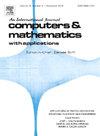nurbs -发散-无网格(NDM)方法
IF 2.5
2区 数学
Q1 MATHEMATICS, APPLIED
引用次数: 0
摘要
在这项研究中,我们提出了一个新的公式,该公式应用NURBS参数空间中的散度定理来使用无网格技术离散控制方程。我们将这种方法称为nurbs -发散-无网格(NDM)方法。该方法利用参数空间的矩形结构,不仅精确地表示了区域,而且简化了线积分的表达式和过程。NDM的主要优点在于它使用了散度定理,它通过确保线积分产生所需的方程数来简化控制方程的离散化。它还可以在缺乏Kronecker delta特性的插值方案中直接施加边界条件,例如移动最小二乘(MLS)。为了说明基本概念,给出了一个简单标量问题的离散化和求解。采用最小二乘插值或径向基函数(RBF)插值对方程进行离散化,并利用散度定理给出了得到的代数方程。收敛性研究表明,非重叠NDM-MLS表现最好,具有所有预期的有利特性。本文章由计算机程序翻译,如有差异,请以英文原文为准。
NURBS-Divergence-Meshless (NDM) method
In this study, we present a new formulation that applies the divergence theorem within the NURBS parameter space to discretize governing equations using meshless techniques. We refer to this method as the NURBS-Divergence-Meshless (NDM) method. In this method, NURBS not only represents the domain exactly but also simplifies both the expression and the process of line integration, benefiting from the rectangular structure of the parameter space.
The primary advantage of NDM lies in its use of the divergence theorem, which simplifies the discretization of governing equations by ensuring that the line integral yields the required number of equations. It also enables the direct imposition of boundary conditions in interpolation schemes lacking the Kronecker delta property, such as moving least squares (MLS).
To illustrate the foundational concept, the discretization and solution of a simple scalar problem are presented. The equation is discretized using either the MLS or radial basis function (RBF) interpolation, with the divergence theorem providing the resulting algebraic equations. Convergence studies show that the non-overlapping NDM-MLS performs best, exhibiting all the anticipated favorable characteristics.
求助全文
通过发布文献求助,成功后即可免费获取论文全文。
去求助
来源期刊

Computers & Mathematics with Applications
工程技术-计算机:跨学科应用
CiteScore
5.10
自引率
10.30%
发文量
396
审稿时长
9.9 weeks
期刊介绍:
Computers & Mathematics with Applications provides a medium of exchange for those engaged in fields contributing to building successful simulations for science and engineering using Partial Differential Equations (PDEs).
 求助内容:
求助内容: 应助结果提醒方式:
应助结果提醒方式:


